The main mistakes when installing sockets and switches, how to prevent them
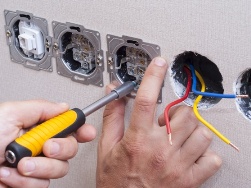 Wanting to install a socket or switch during repair or just intending to replace an obsolete model with a more modern one, we usually decide to do it ourselves. As a rule, such a decision is connected with a very misconception about what and how to do, with absolute confidence, however, in their abilities and strengths.
Wanting to install a socket or switch during repair or just intending to replace an obsolete model with a more modern one, we usually decide to do it ourselves. As a rule, such a decision is connected with a very misconception about what and how to do, with absolute confidence, however, in their abilities and strengths.
In reality, having no experience installing sockets or switches, not a single newcomer is immune from error. Due to the lack of proper experience, he can simply ruin the device or even damage the wiring, without paying attention to some important nuances that professionals know about. Meanwhile, frenzied zeal in such situations can end tragically, from electric shock to fire. In order to somehow prepare a beginner and warn him against possible failures, let's look at some important aspects of installing switches and sockets ...
Why is the warning lamp dangerous and why is it prohibited by the rules
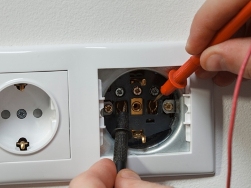 While the light is on, and all home electrical appliances are working, everything is fine, but as soon as the machine is knocked out, you have to find and fix the malfunction. Well, if the owner of the home is an experienced electrician, then he probably has a phase indicator in the shape of a screwdriver in his home tool, or certainly a multimeter. But what if there is neither one nor the other in the household? Is there any other way to safely detect a malfunction in an electrical circuit?
While the light is on, and all home electrical appliances are working, everything is fine, but as soon as the machine is knocked out, you have to find and fix the malfunction. Well, if the owner of the home is an experienced electrician, then he probably has a phase indicator in the shape of a screwdriver in his home tool, or certainly a multimeter. But what if there is neither one nor the other in the household? Is there any other way to safely detect a malfunction in an electrical circuit?
As a rule, in such cases, some home craftsmen resort to the help of the so-called warning lamp, which, incidentally, is very unsafe and generally prohibited by safety regulations. For this reason, a phase indicator is still better to have on the farm. But why is the warning lamp prohibited? Let's try to understand this in detail. Incandescent lamps, which are usually used as a control lamphave a bad habit of failing at the most unexpected moment ...
What is electrical resistance and how does it depend on temperature
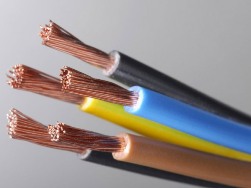 From the point of view of the electromagnetic process occurring in it, any element or section of an electric circuit is primarily characterized by the ability to conduct current or impede the passage of current. This property of circuit elements is evaluated by their electrical conductivity or magnitude, reverse conductivity - electrical resistance.
From the point of view of the electromagnetic process occurring in it, any element or section of an electric circuit is primarily characterized by the ability to conduct current or impede the passage of current. This property of circuit elements is evaluated by their electrical conductivity or magnitude, reverse conductivity - electrical resistance.
Most electrical devices consist of conductive parts made of metal conductors, usually equipped with an insulating coating or sheath. The electrical resistance of a conductor depends on its geometrical dimensions and material properties. The resistivity and conductivity take into account the properties of the material of the conductor and give the values of resistance and conductivity of the conductor 1 m long and a cross-sectional area of 1 mm2. By the value of resistivity ρ, all materials can be divided ...
What is included in a modern electrical panel. Basic components for home electrical panels
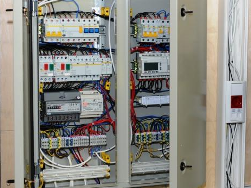 Any private house or apartment in a multi-storey building must have its own electrical panel. In the classic form, the electrical panel looks like a metal box with a door, and various devices and a meter are installed inside (or meters, if the panel refers, for example, to several apartments located on the same platform at the entrance).
Any private house or apartment in a multi-storey building must have its own electrical panel. In the classic form, the electrical panel looks like a metal box with a door, and various devices and a meter are installed inside (or meters, if the panel refers, for example, to several apartments located on the same platform at the entrance).
For an absolutely uninitiated person, the devices located behind the door are something transcendental, it is not clear why they are standing there.Meanwhile, an electrical panel is a necessary, but unsafe thing, so it’s better not to climb into it without the need and qualifications. The distribution and accounting board (as it is correctly called) is initially designed and installed by specially trained craftsmen (electrical engineers) during the design and electrical installation works. They design the wiring, choose the future location for the installation of the shield ...
The use of transformers in power supplies
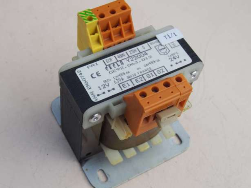 Different parts of electrical appliances, as a rule, need a different voltage supply. In order to ensure this, transformers with several secondary windings issuing different voltages are used in the power supply units of these devices, or several separate transformers are used, each of which provides its own specific voltage.
Different parts of electrical appliances, as a rule, need a different voltage supply. In order to ensure this, transformers with several secondary windings issuing different voltages are used in the power supply units of these devices, or several separate transformers are used, each of which provides its own specific voltage.
So, for example, in old televisions (with CRT tubes), 5-7 volts for powering transistors, microcircuits, or lamps were obtained from one transformer, and several kilovolts for powering the picture tube anode - from another - a high-voltage, so-called horizontal transformer. This transformer further fed the voltage multiplier, which several times increased the high voltage received from the secondary winding of the line generator. In the old days, when pulsed semiconductor technology was not ...
The most energy-consuming household appliances
 The life of a modern person is inconceivable without electrical appliances. We cook and reheat food, store food, do cleaning, wash, iron, work at the computer, spend leisure time, etc. All their life, people interact with electrical appliances, using them to provide a more comfortable and more efficient life for themselves and their loved ones.
The life of a modern person is inconceivable without electrical appliances. We cook and reheat food, store food, do cleaning, wash, iron, work at the computer, spend leisure time, etc. All their life, people interact with electrical appliances, using them to provide a more comfortable and more efficient life for themselves and their loved ones.
But have you ever wondered how much electricity all these household appliances consume together and individually? Indeed, many of us often think about saving energy. And how to achieve this if you do not calculate consumption? Let’s count what our comfortable, so-called civilized everyday life turns into. First of all, in order to calculate the consumption, it is necessary to know the power of each household appliance, that is, the number of watts consumed in normal daily operation. On any device, as a rule, there is a plate ...
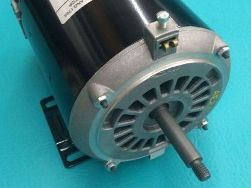 Depending on the purpose, on the expected operating modes and conditions, on the type of power supply, etc., all electric motors can be classified according to several parameters: by the principle of obtaining the operating moment, by the method of operation, by the nature of the supply current, by the method of phase control, by type of excitation, etc. Let us consider the classification of electric motors in more detail.
Depending on the purpose, on the expected operating modes and conditions, on the type of power supply, etc., all electric motors can be classified according to several parameters: by the principle of obtaining the operating moment, by the method of operation, by the nature of the supply current, by the method of phase control, by type of excitation, etc. Let us consider the classification of electric motors in more detail.
Torque in electric motors can be obtained in one of two ways: by the principle of magnetic hysteresis or purely magnetoelectric. A hysteresis motor receives torque through the hysteresis during magnetization reversal of a magnetically solid rotor, while in a magnetoelectric motor the torque is the result of the interaction of the explicit magnetic poles of the rotor and stator. Magnetoelectric motors rightfully make up the lion's share of the total abundance of electric motors ...
Vacuum devices yesterday and today
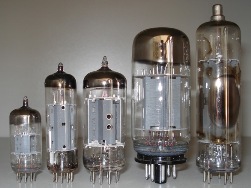 In the age of integrated circuits and smartphones, chips and supercomputers, it would seem ridiculous to think about electro-vacuum devices, such as electronic radio tubes. Everywhere they were replaced by transistors, and they had a place in the museum for a long time. Of course, there is some truth in these statements, nowadays the lamps are really not as widely used as before, nevertheless, to this day there remain areas in which they are indispensable and very popular.
In the age of integrated circuits and smartphones, chips and supercomputers, it would seem ridiculous to think about electro-vacuum devices, such as electronic radio tubes. Everywhere they were replaced by transistors, and they had a place in the museum for a long time. Of course, there is some truth in these statements, nowadays the lamps are really not as widely used as before, nevertheless, to this day there remain areas in which they are indispensable and very popular.
Indeed, the principle of operation of the kenotron, triode, and other electrovacuum devices is not so complicated. Between the electrodes inside the evacuated housing, an electron flow is initiated. The intensity and direction of this electron flow can be controlled using an electric or magnetic field.Electric current in a vacuum is striking in its properties: a lamp can generate oscillations in the widest frequency range, from sound to radio waves ...
